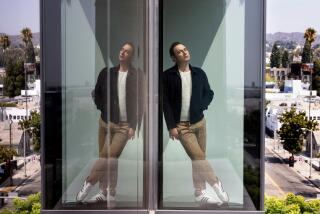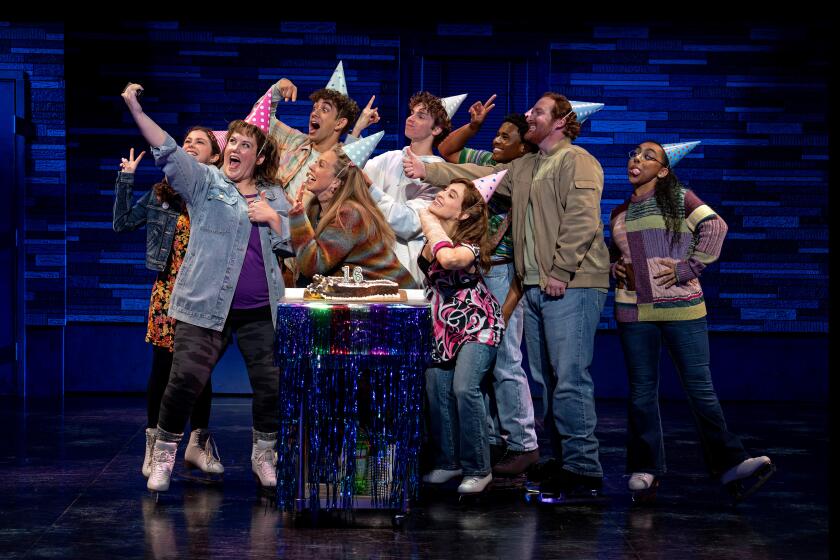STAGE REVIEW : ‘Sugarhill’ Is a Tasty Bite : Jonelle Allen’s performance is a sketchy but lovingly felt bit of tribute and mischief about the Harlem that gave her her first exposure to jazz, dance and the yen to entertain.
The Harlem that Jonelle Allen remembers, the Harlem that’s at the heart of her stage reflection “Easter on Sugarhill,” isn’t marred by drug dealers, poverty or any other of the urban ills that have come to characterize the famous New York City ‘hood.
Instead, it’s a community of “tree-lined streets where kids rode bicycles that weren’t stolen . . . and where people voted Republican because Lincoln was a Republican.”
It also was where Allen, a veteran actress with a resume that spans Broadway (“Hair” and “Two Gentlemen of Verona”) and television (“Hill Street Blues” and “L.A. Law”), got her first tastes of jazz, dance and the yen to entertain.
“Easter on Sugarhill” is essentially a testimonial to all of that, a sketchy but lovingly felt bit of tribute and mischief. Written and directed by Mary Anne McGarry from Allen’s stories about her high-steppin’ youth in Harlem’s Sugarhill district during the ‘50s and ‘60s, it was performed twice by Allen Sunday night at the Engman International art gallery as part of the monthly “Making Scenes” dramatic series there.
Only 45 minutes long, it zoomed by, largely because of the energy Allen brought to it.
Transitions in tone, from playful to solemn to naughty, weren’t always bumpless, but even the awkward moments passed quickly, pushed aside by Allen’s resolve to be appealing. Allen’s resourcefulness was tested by the space she had to work in (without a raised stage, it wasn’t the best environment to show off her dancing), but the performance came across as “the labor of love” it was advertised to be.
Allen set the tone with the opening number, a purring rendition of “Easter Parade” that featured a duet with her dance partner, Mel Jackson, and accompaniment by musical director Mark Turnbull on guitar. Soon after that, Allen noted that folks have their preconceptions about where she grew up: “Oh, you poor thing,” they tell her, “ ‘What was it like growing up in Harlem?’ . . . And I get that from people from Fresno . . . black people from Fresno!”
From there, it was a speedy journey through a childhood of impromptu concerts in the kitchen with such imaginary guests as Bob Hope and Harry Belafonte--and not-so imaginary successes such as performing with Helen Hayes in a revival of “The Wisteria Tree” when Allen was only 5.
Allen took a little detour to point out that her idol at that point in her life was Lena Horne. She said it, then she sang it with a worshipful version of “Stormy Weather.”
The most interesting passages of the evening came when Allen dwelled on the Harlem Renaissance of the ‘20s and ‘30s that helped produce such writers as Langston Hughes. To Allen the period was a symbol of the black community at its most brilliant--though as she recalled with amusement, to “Auntie B,” the woman who took care of her, “Harlem Renaissance” only meant the name of a local dance club that she’d blithely nicknamed “the Rennie.”
That in turn provided a pathway for some hot to cool ponderings on jazz and her own budding sexual awareness. While M.B. Hanif played a bluesy sax in the background, Allen talked about jazz great Sonny Rollins growing up in her neighborhood, and a local musician, “Brother Hodges,” who showed her what the horn was really all about.
“Easter on Sugarhill” marks the second valuable offering in the “Making Scenes” series, a collaboration of local professional artists. The series started in March with McGarry’s well-received “Honeymoon in Galway” and will continue May 31 with a program focusing on Memorial Day remembrances.
More to Read
The biggest entertainment stories
Get our big stories about Hollywood, film, television, music, arts, culture and more right in your inbox as soon as they publish.
You may occasionally receive promotional content from the Los Angeles Times.










